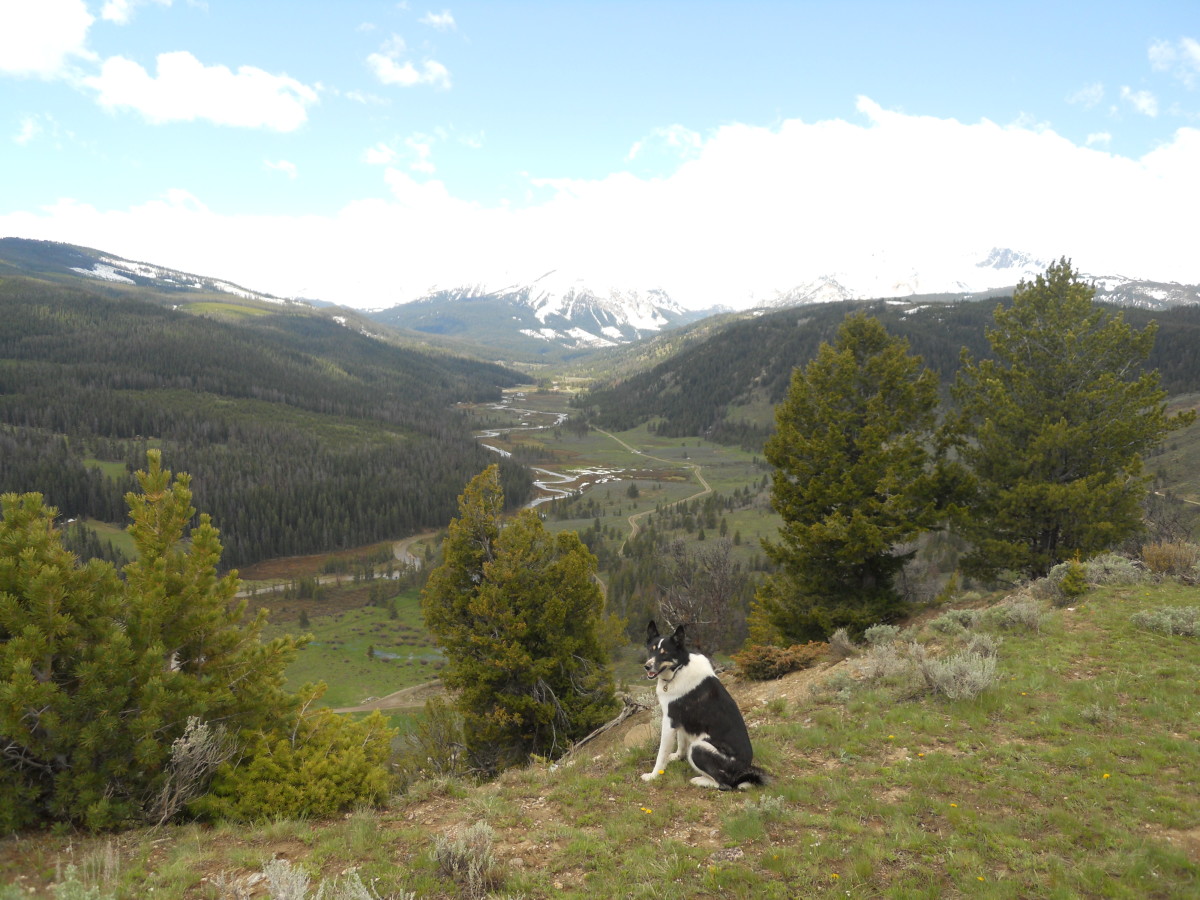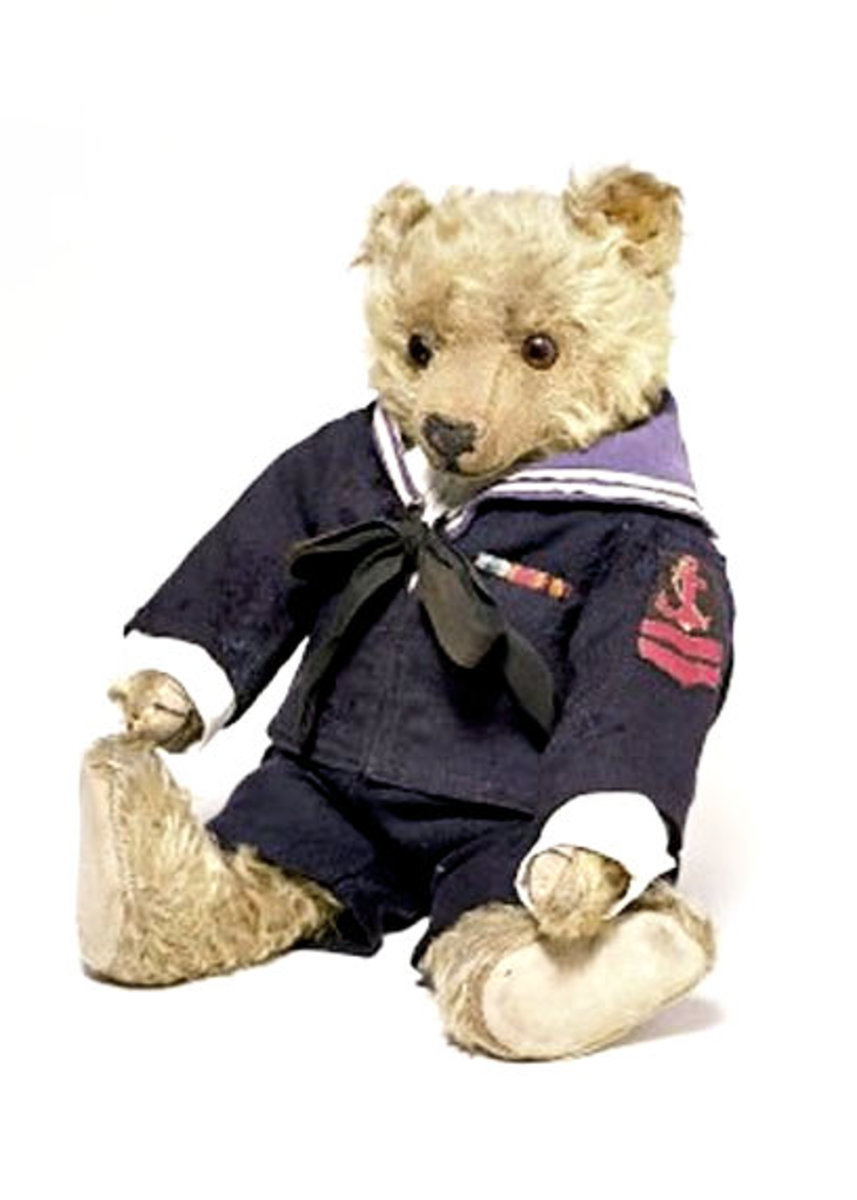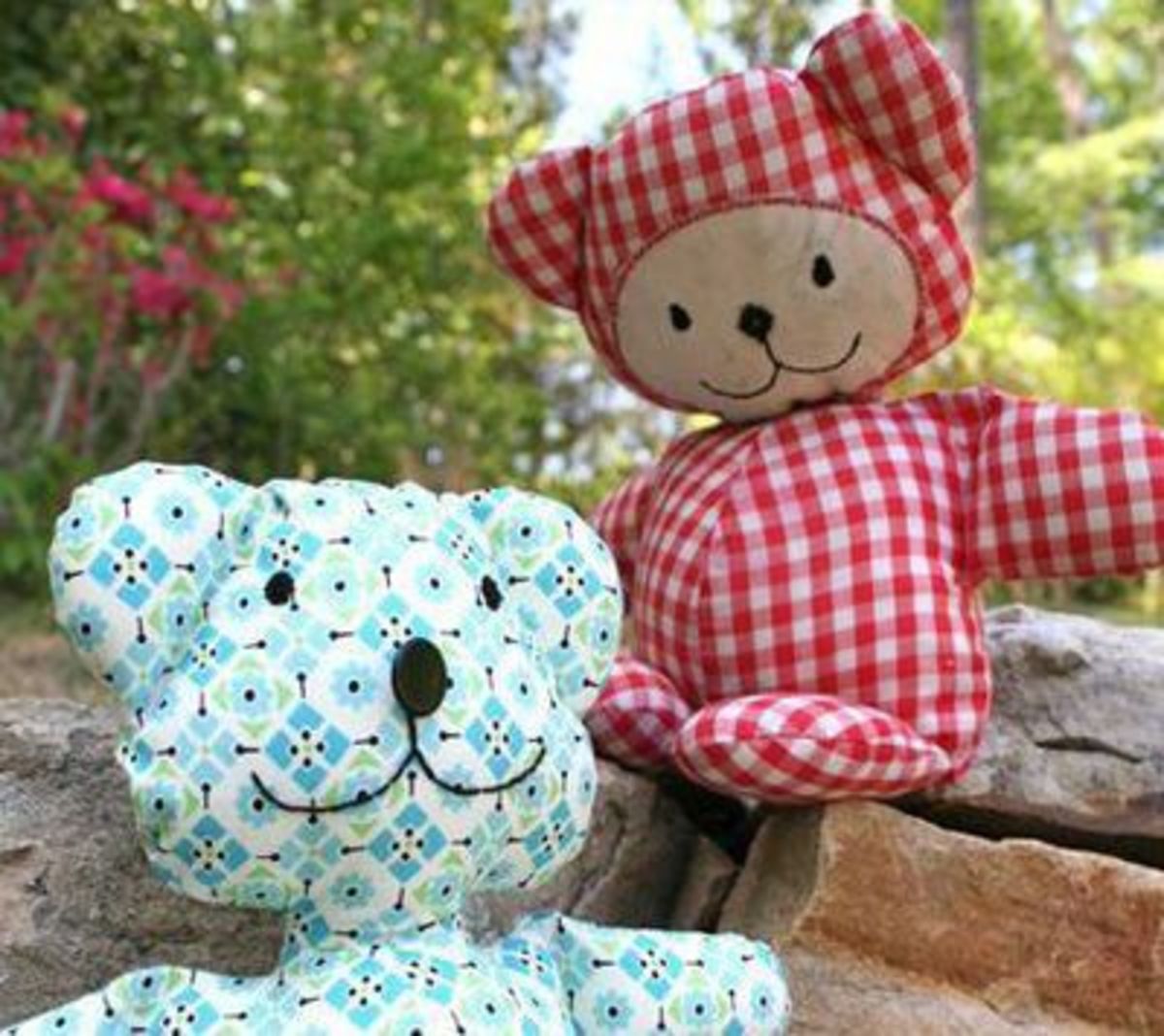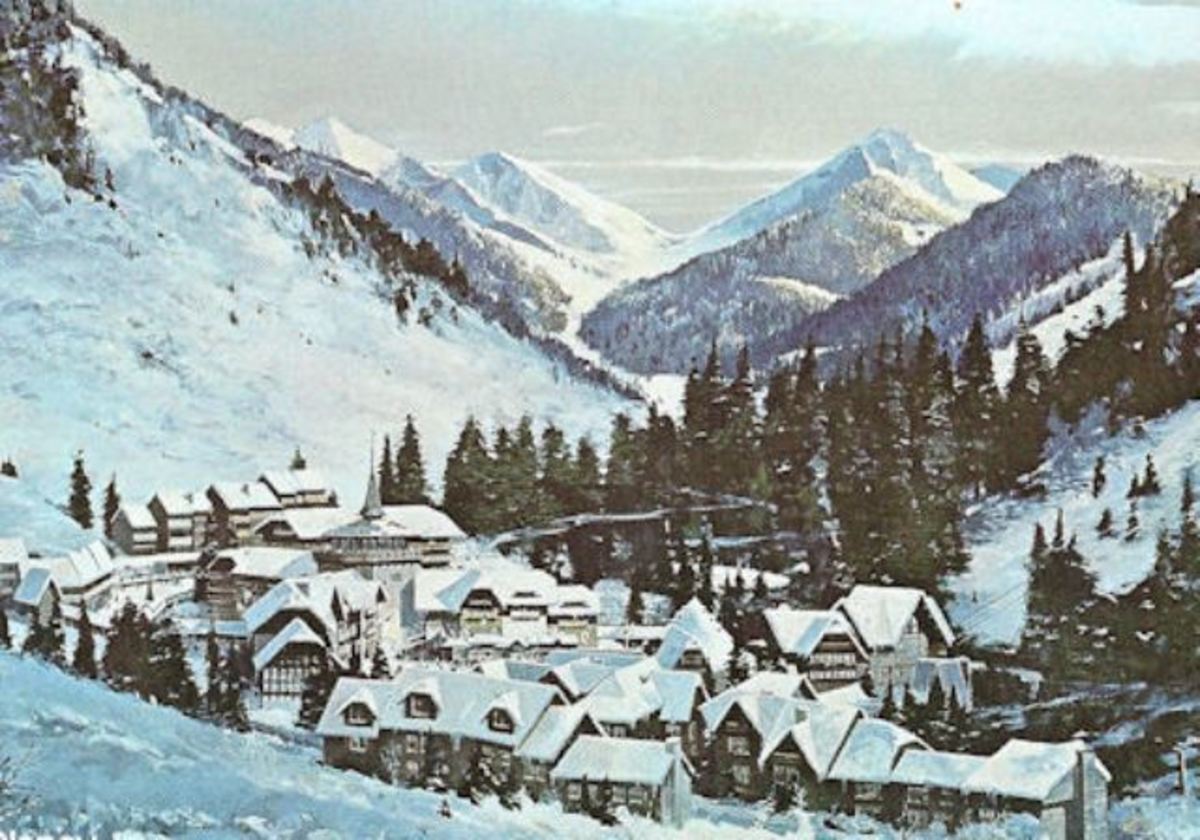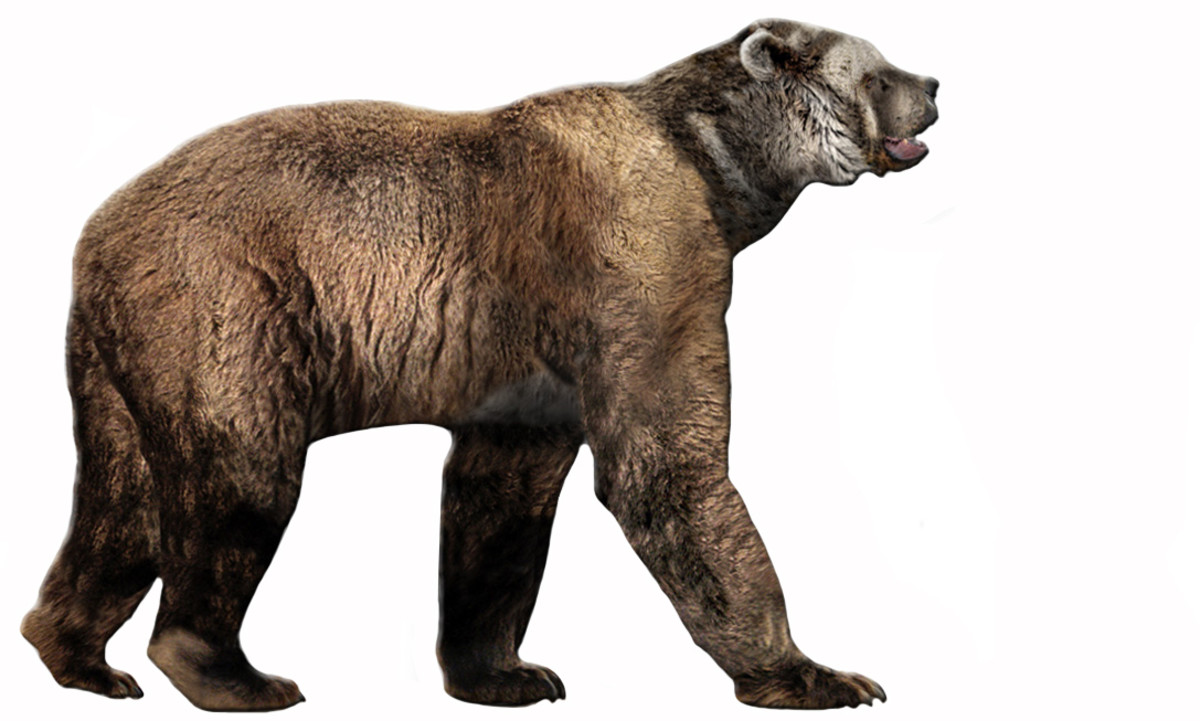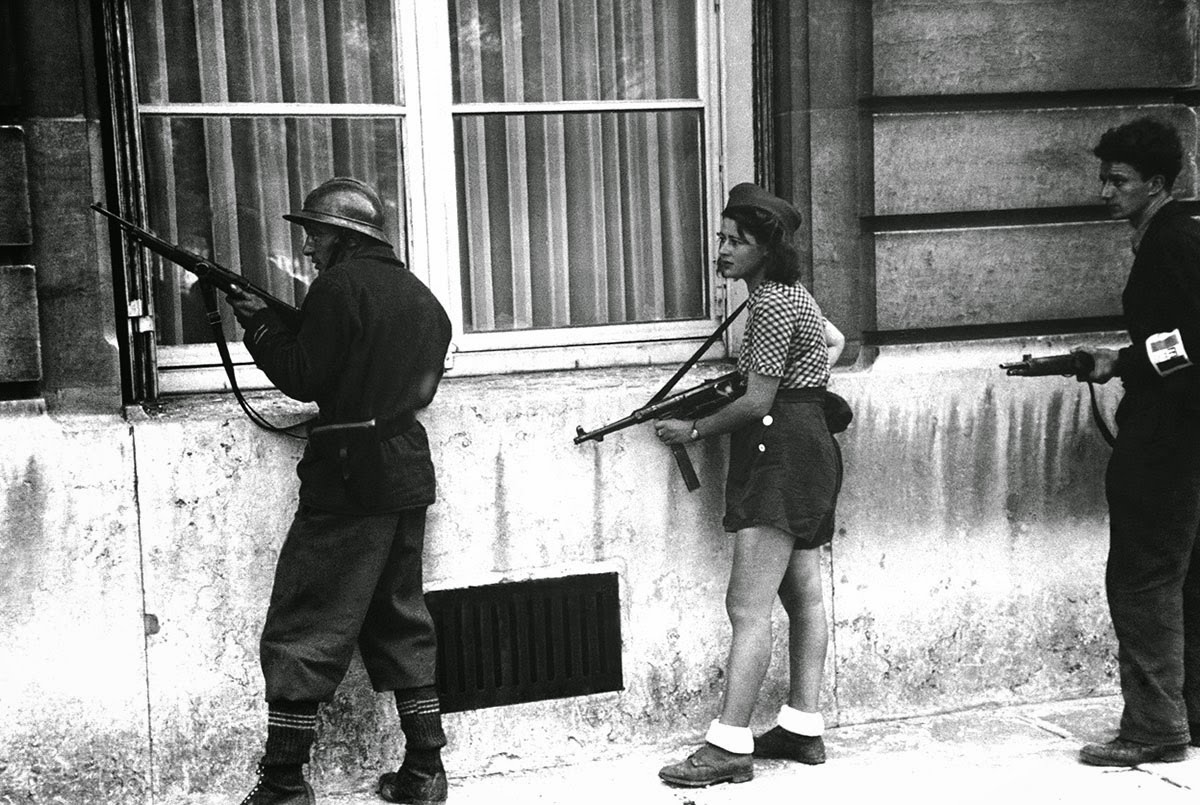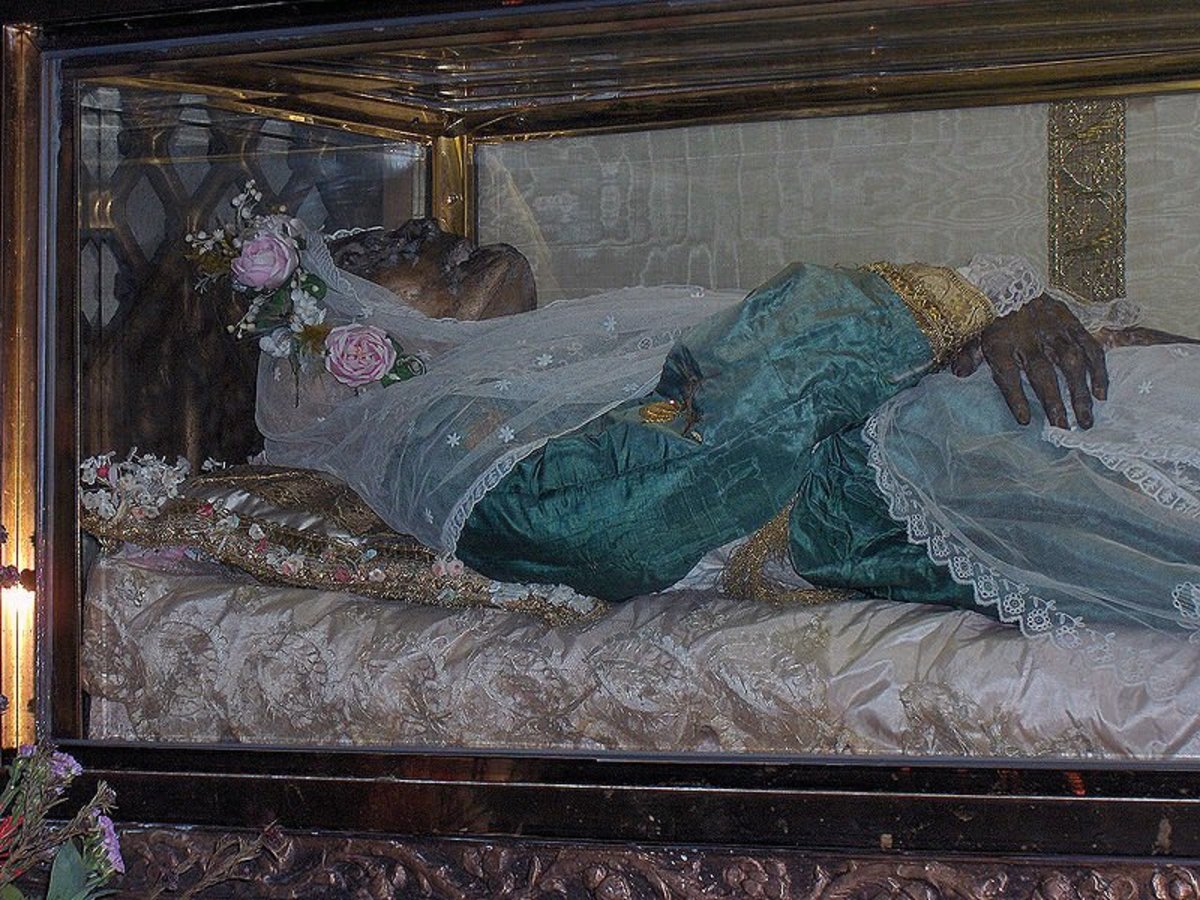Spikehorn Meyers and His Harrison Michigan Bear Roadside Attraction
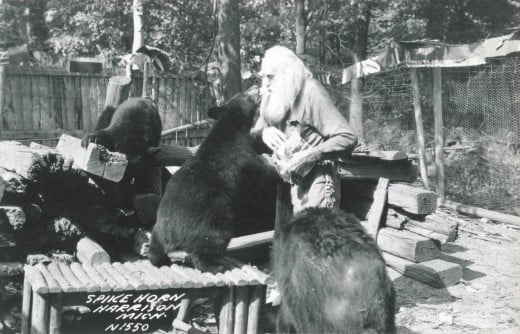
The Bear Man in the History of Harrison Michigan
Harrison, Michigan – a small town along the old US-27 highway – holds a unique place in Michigan lore. One chapter stands out in particular: the history of Harrison, Michigan, isn’t complete without the tale of Spikehorn Meyers and his famous roadside bear camp. From 1930 to 1950, this eccentric local character turned a quiet patch of woods into a bustling tourist attraction. Travelers from Detroit, Lansing, and beyond would pull over, stretch their legs, and find themselves face-to-face with live bears. It sounds like folklore, but it’s true. Spikehorn Meyers’ bear den became one of the most talked-about roadside attractions in the history of Harrison, Michigan, and indeed the entire state.
Video - Spikehorn Meyers’ Bear Camp in Harrison, Michigan (1930–1959)
In the 1930s and 1940s, motorists driving through Harrison, Michigan often stopped at a roadside attraction unlike any other: Spikehorn Meyers’ Bear Den. Here, an eccentric old woodsman dressed in buckskin invited families to feed, pet, and even shake hands with live black bears. For nearly three decades, John “Spikehorn” Meyer turned his rustic camp into a legendary stop along US-27. Visitors gasped as bears sipped soda from glass bottles and nibbled popcorn from their hands. Spikehorn became both a beloved folk hero and a thorn in the side of state conservation officers, proudly displaying a sign that read, “Feed Conservation Officers to the Bears.”
In this episode, we revisit the life of Spikehorn Meyers, his colorful partnership with “Chief Red Eagle,” and the unforgettable stories of the Bear Den. It’s a tale of showmanship, danger, humor, and the unique roadside history that shaped small towns across Michigan.
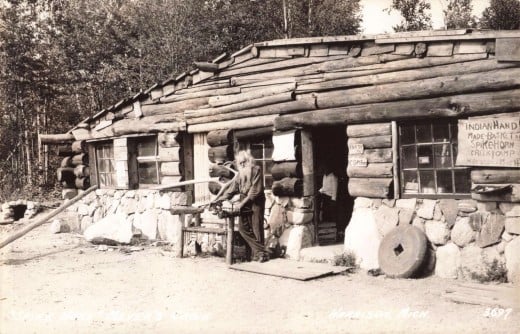
A Rustic Camp with Real Bears
In the early 1930s, John “Spikehorn” Meyer (often called Spikehorn Meyers by locals) opened Spikehorn’s Bear Den and Wildlife Park on his property at the corner of Old US-27 and M-61. At a time when the History of Harrison, Michigan, was entering the era of automobile tourism, Spikehorn created something truly original. His camp was a simple, rustic setup – a log cabin, a few pens and sheds, and hand-painted signs inviting visitors in. What drew people from miles around were Spikehorn’s pet black bears. He had raised many of them from cubs, and they roamed freely around the wooded camp like oversized dogs. There were no cages between you and the bears, an almost unimaginable situation today. Visitors could buy a cup of popcorn or a piece of candy and feed Spikehorn’s bears by hand. Photographs from that era show curious children petting yearling cubs and laughing as bears sipped orange soda from glass bottles. The history of Harrison Michigan tourism was forever marked by these incredible interactions between man, child, and bear.
Spikehorn himself was as fascinating as the animals. By the time he started the bear camp, he was already in his 60s. He wore buckskin clothes he sewed himself, complete with fringe and a rawhide belt. He carried an antique musket on his shoulder for effect. With his flowing white beard and hair, Spikehorn looked like a figure from a pioneer story. In fact, he had been a lumberjack, a miner, and even an inventor earlier in life. But it wasn’t until he embraced the persona of “the Bear Man” that he found fame. He would cheerfully pose for photographs with visitors, often cradling a bear cub in his arms. Parents who stopped at the camp might leave with a souvenir postcard of Spikehorn and his bears – a token of Harrison, Michigan, history to show friends back home.
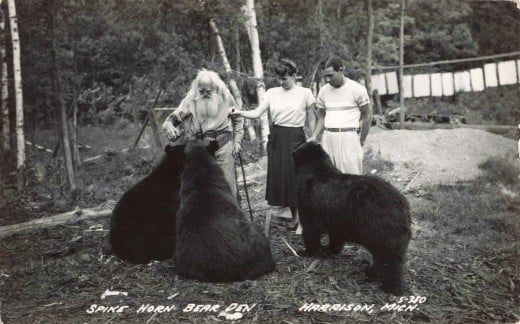
Tall Tales and Wild Adventures
A big part of Spikehorn’s success was his showmanship. Every day at the camp was a performance. Spikehorn loved to tell stories, and he wasn’t too concerned about truth versus exaggeration. In the evenings, he would gather everyone around the campfire. With the twilight settling in and crickets chirping, Spikehorn spun yarns about wrestling bear cubs or surviving blizzards in the woods. Children sat wide-eyed, clutching their parents’ sleeves as he described some daring wilderness escapade. Assisting in the entertainment was Spikehorn’s friend and business partner, Chief Red Eagle. Red Eagle was actually an African American man who donned a feathered headdress and traditional-style clothing to play the role of a Native American “chief”. This character may not meet modern standards of cultural representation, but in that era, he added an exotic flair to the camp’s performances. Together, the white-bearded woodsman and the self-styled chief created a memorable spectacle. Their stories and playful banter gave visitors more than just bears to remember – they offered a slice of fantasy and theater.
One of Spikehorn’s favorite gimmicks was encouraging visitors to shake hands with the bears. He taught some of his tame bears to offer a paw when approached. Incredibly, many travelers took the challenge. A prominent sign at the park entrance read, “Only bear den in the world where visitors are allowed to shake hands with a bear.” It was a bold promise. By most accounts, Spikehorn delivered on it – at least for those brave enough to try. Not everyone left unscathed, however. There were a few well-publicized incidents of bears scratching or biting tourists. In one 1948 case, a little girl posing for a photo got grabbed and pulled by a bear through a fence, suffering cuts before she was freed. Another time, a Boy Scout needed first aid after a bear cub gave him a scratch on the back. These events caused concern and a bit of scandal. But remarkably, they did little to dent Spikehorn’s popularity at the time. If anything, the history of Harrison Michigan shows that some danger only added to the allure of the bear camp. Many visitors simply brushed it off as the price of an authentic adventure.
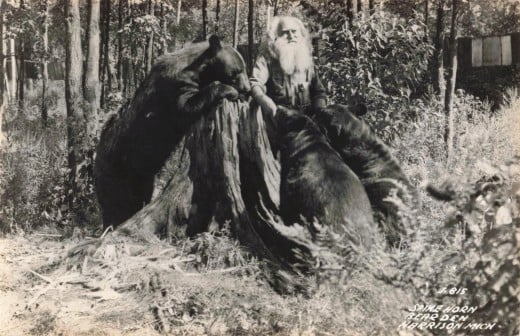
Clashes with Conservation Authorities
Not everyone was enamored with Spikehorn Meyers’ operation. Michigan conservation authorities (the forerunners of today’s Department of Natural Resources) grew increasingly concerned as the bear den’s fame – and attendance – grew. By modern standards, the camp was a liability nightmare: wild animals mingling with untrained people, no formal safety measures, and an owner who boasted about bending the rules. Starting in the late 1930s, officials tried to rein Spikehorn in. They passed a law in 1937 requiring him to keep his bears penned. Spikehorn complied by building pens, but he had a loophole – he would personally escort visitors right into the bear pen if they wanted an up-close encounter! Needless to say, the state was not pleased.
Spikehorn’s relationship with the authorities quickly turned hostile and even humorous. When game wardens or conservation officers came by the property, Spikehorn would meet them with loud complaints. He argued that his bears were like his children and that he had a natural right to keep them. After a series of legal warnings and fines, Spikehorn upped the ante. He painted a big sign and placed it prominently in front of his camp. It read: “FEED CONSERVATION OFFICERS TO THE BEARS.” This cheeky slogan became famous across Michigan and encapsulated Spikehorn’s defiant spirit. Locals chuckled at the jab at authority. The officers, as one might imagine, were not amused. Over the years, Spikehorn was dragged into court a number of times for various violations – from not having proper permits to alleged animal cruelty (the latter he vehemently denied, as he truly loved his bears). Each time, he managed to escape serious punishment, either through legal maneuvering or sheer luck.
By the 1940s, Spikehorn Meyer was not just a local oddball – he was a regional celebrity. He appeared in newsreels and on radio programs, often bringing along a bear cub to surprise the hosts. He even ran for state representative three times in the 1940s on a platform that included abolishing property taxes. Voters didn’t send him to Lansing, but his campaigns kept his name in the papers. In many ways, Spikehorn knew how to turn any publicity – even a negative story about a bear attack or an arrest – into an advertisement for his camp. Parents might shake their heads, but many still thought, “Maybe we should stop by Harrison and see those bears for ourselves.” Thus, the history of Harrison Michigan in that era is inseparable from this larger-than-life character who challenged the rules in pursuit of his dream.
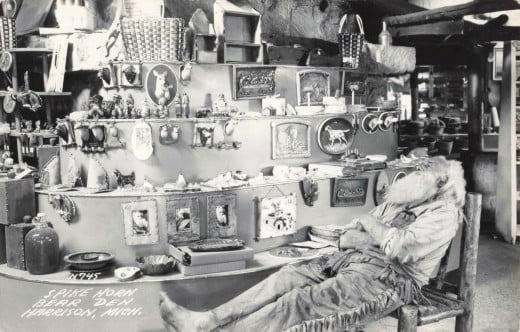
The End of an Era and Lasting Legacy
As the 1950s arrived, Spikehorn Meyers was well into his eighties and still tending his bears daily. The world around him was changing – the interstate highway system was on the horizon, which would eventually divert traffic away from Old 27, and public attitudes toward roadside menageries were slowly shifting. Still, Spikehorn kept entertaining visitors with the same old charm. Many of the bears he started with had grown old alongside him. Photographs from the mid-1950s show Spikehorn looking a bit more frail but still smiling broadly, a bear cub in his lap.
Fate intervened in January 1957. A fire broke out in Spikehorn’s cabin and souvenir shop, likely due to an accident with a wood-burning stove. The blaze destroyed the little museum and gift store that were part of the camp, as well as supplies of feed and many personal belongings. Spikehorn himself barely escaped. The disaster could have been the end right then – he was 86 years old, and a lifetime of work lay in ashes. But Spikehorn’s story had one more twist. He announced he would rebuild. According to local legend, a wealthy woman offered him a large sum of money (reportedly $60,000) to help restore the bear den. Spikehorn refused, joking that the offer “was just her way of trying to get me to marry her.” He said he wouldn’t consider marriage until he was 100 years old, and even then, he’d only marry a rich woman so he could be “the richest man in the cemetery”. It was a final example of Spikehorn’s indomitable and quirky spirit.
Amazingly, by the fall of 1957, Spikehorn had partially rebuilt and reopened the bear den. His determination was as much a draw as the bears at that point. However, just months later, Spikehorn suffered a stroke that left him unable to walk or care for his beloved animals. Reluctantly, he had to shut down the park for good. The following year, he was moved to a nursing home. John “Spikehorn” Meyer died on September 19, 1959, at the age of 89. He had never married and had no children. In a poetic way, the end of Spikehorn’s life marked the end of an era for Harrison. The bear camp could not outlive the man who embodied it.
Today, more than sixty years later, there isn’t much left to see of Spikehorn’s camp. If you drive by the old site at M-61 and what used to be US-27 (now a business route), you might notice some stone chimneys or foundations being slowly overtaken by weeds. Most people pass by without realizing what once happened there. But for those who know the history of Harrison Michigan, Spikehorn Meyers remains a legend. He’s remembered as the Bear Man – the eccentric who welcomed strangers into his world of woods and wildlife. Local historical societies occasionally share stories and photos of Spikehorn with new generations, ensuring his memory doesn’t fade completely. Collectors still prize the old postcards and souvenirs from Spikehorn’s Bear Den, which pop up at flea markets from time to time. And in the broader lore of Michigan, Spikehorn’s story stands alongside tales of Paul Bunyan and other tall tales – except his was absolutely true.
Final Thoughts
Spikehorn Meyers’ bear camp may be long gone, but its story endures as a fascinating, cautionary, and heartwarming chapter in the history of Harrison, Michigan. It reminds us of a time when the call of the wild met the open road, and when one man’s passion for nature left an indelible mark on a small town forever.
Sources
-
“1959: Spikehorn Meyer Passes Away, Owner of Bear Den and Deer Park in Harrison.” Michigan Day by Day, 10 Oct. 2018, harris23.msu.domains/event/1959-spikehorn-meyer-passes-away-owner-of-bear-den-and-dear-park-in-harrison/.
-
Dakohta, Devinn. “The Wild Man Named Spikehorn Who Slept Beside Bears and Brawled With Everyone.” Michigan Enjoyer, 4 Aug. 2025, enjoyer.com/the-wild-man-named-spikehorn-who-slept-with-bears-and-brawled-with-everyone/.
-
Hufford, Deborah. “Bear Whisperer – Spikehorn Meyers.” Notes from the Frontier, 6 Apr. 2020, www.notesfromthefrontier.com/post/bear-whisperer-spikehorn-meyers.
-
“TBT: Spikehorn Meyers and His Bears.” Michigan in Pictures, 7 Aug. 2014, michpics.wordpress.com/2014/08/07/tbt-spikehorn-meyers-and-his-bears/.

